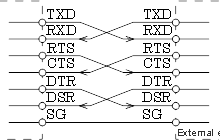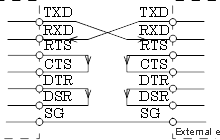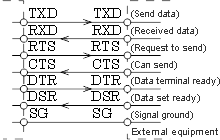Contents
What is serial communication?
Serial communication is a communication method that uses one or two transmission lines to send and receive data, and that data is continuously sent and received one bit at a time.Since it allows for connections with few signal wires, one of its merits is its ability to hold down on wiring material and relaying equipment costs.
Serial communication standards
RS-232C/RS-422A/RS-485 are EIA (Electronic Industries Association) communication standards.Of these communication standards, RS-232C has been widely adopted in a variety of applications, and it is even standard equipment on computers and is often used to connect modems and mice.Sensors and actuators also contain these interfaces, many of which can be controlled via serial communication.
RS-232C
This serial communication standard is widely used and is often equipped on computers as standard.It is also called "EIA-232".The purpose and timing of the signal lines and the connectors have been defined (D-sub 25-pin or D-sub 9-pin).Currently the standard has been revised with the addition of signal lines and is formally called "ANSI/EIA-232-E".However, even now it is generally referred to as "RS-232C".
RS-422A
This standard fixes problems in RS-232C such as a short transmission distance and a slow transmission speed.It is also called "EIA-422A".The purpose and timing of the signal lines are defined, but the connectors are not.Many compatible products primarily adopt D-sub 25-pin and D-sub 9-pin connectors.
RS-485
This standard fixes the problem of few connected devices in RS-422A.It is also called "EIA-485".RS-485 is forward compatible standard with RS-422A.The purpose and timing of the signal lines are defined, but the connectors are not.Many compatible products primarily adopt D-sub 25-pin and D-sub 9-pin connectors.
Signal assignments and connectors
In RS-232C, the connectors to use and the signal assignments have been defined and are standardized.The figure to the right describes the D-sub 9-pin signal assignments and signal lines.
Connection method
In RS-232C, the connectors and signal assignments have been standardized, so many standard-compliant cables are available commercially.However, equipment comes in the following types, and depending on the equipment that will be connected, a straight cable or a crossover cable is required.
Equipment type
DCE
Data communication equipment.This term indicates equipment that passively operates such as modems, printers, and plotters.
DTE
Data terminal equipment.This term indicates equipment that actively operates such as computers.
- Crossover cable connection (1)
-

- Crossover cable connection (2)
-

- Straight cable connection
-

Half-duplex communication and full-duplex communication
- Full-duplex communication
- A method where send and receive both have their own transmission line so data can be simultaneously sent and received.
- Half-duplex communication
- A method where communication is performed using one transmission line while switching between send and receive.For this reason, simultaneous communication cannot be performed.
Asynchronous communication and synchronous communication
In serial communication, data is sent one bit at a time using one signal line, so in order for the receiving side to accurately receive the data, the sending side must know at what speed it is sending each bit.In RS-232C, synchronous communication and asynchronous communication standards have been defined.For peripheral equipment used for measurements or control, the previously mentioned full-duplex communication and asynchronous communication are typically used.
- Synchronous communication
- This method sends and receives data synchronized to a clock generated by the other equipment or by a self-generated clock.Communication is performed is based on a synchronization signal added to each bit from the sending side.This has good data transmission efficiency but there is a demerit in that the transmission procedure becomes complicated.
- Asynchronous communication
- This method sends and receives data synchronized to each side's own self-generated clock.Normal communication is not possible if the transmission rate settings do not match.In other words, both the sending side and the receiving side initially agree on how many bits to transfer each second, and then each creates a synchronization signal of a frequency that matches that transmission rate. In asynchronous communication, data is sent and received one bit at a time on one data line, so if each side's communication condition settings do not initially match, normal communication is not possible.Matching the computer (controller) side settings to the peripheral equipment side settings is the normal setup method.
- Transmission rate
- Specifies the number of bits to send each second.The unit is bps (bits per second) and is selected from 300, 600, 1200, 2400, 4800, 9600, 19200, and so on.By matching the settings and timing, the data delimiters correspond, and data can be normally sent and received.For this reason, a start bit is added to each item of data (1 byte) to acquire the correct timing.

- Stop bit length
- This sets the length of the bit that indicates the end of the data.This is normally selected as 1 bit, 1.5 bits, or 2 bits.The start bit length is fixed as 1 bit so this setting is not necessary.
- Data bit length
- This specifies how many bits each item of data is composed from.This depends on the device being used, but normally specify 7 bits for alphanumeric characters and symbols, and specify 8 bits for 1 byte binary data.
- Parity check setting
- This is a function to find errors in the data and is selected from "even parity check (EVEN)", "odd parity check (ODD)", or "no parity check (NONE)".
- Parity check details
- On the sending side, a parity bit of "1" or "0" is added to the data so as to make the number of "1" data bits even for EVEN and odd for ODD.On the receiving side, the number of "1" data bits is counted and the data is judged as being correct if the number is even when EVEN and odd when ODD.

- Handshake (flow control)
- When sending and receiving data between devices, data may be lost when data is sent when the receiving side is not in the receiving state, so it is important in communication to check the other side's state.The handshake (flow control) is a function that maintains the reliability of communications. A signal is sent from the sending side to the receiving side that states, "data is being sent", and the receiving side receives that signal and reads the data from the signal line.Then it sends a reply to the sending side that states, "the data was received".In other words, data can be transferred while each side checks the sending and receiving of data.
- Software handshake (XON/XOFF flow control)
- This is a control method where the "XOFF code" is sent to the sending side to request that sending be temporarily interrupted when the remaining free space in the receive buffer gets low on the receiving side.When there is a sufficient amount of free space, the "XON code" is sent to request that the sending side restart sending.
- Hardware handshake
- The control lines (RTS or DTR) are automatically turned on or off as an alternative to sending the XON/XOFF codes in software flow control.The RTS signal and the CTS signal or the DTR signal and the DSR signal must be connected to each other.